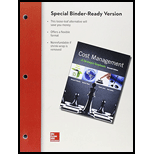
1.
- a. Compute the overall number of seminar participants that will be required to breakeven with the total cost of this joint venture.
- b. Mention the number of participants who will be enrolled by the joint venture to earn a $169,400 after tax income.
1.
Explanation of Solution
Analysis of Cost-Volume-Benefit (CVP) is a tool to examine how different business and marketing strategies impact short-term profit based on an understanding of the relationship between fixed costs, fixed costs, and price per unit of sale and production amount (i.e. volume).
The break-even point is the point where total revenues are equal to total costs, so the operating profit is nil.
CVP analysis is often used in cost planning to determine the cost reduction needed to achieve the target income or to find the necessary increase in fixed costs for a given change in variable costs (or vice versa).
The contribution margin reflects the incremental revenue raised with each product / unit sold following deduction of the variable percentage of the company’s costs.
The break even number of participants is equal to the fixed costs divided by the contribution margin per participant.
- a.
Calculate fixed costs (F):
Calculate contribution margin per participant:
Calculate break-even:
Hence, the overall number of seminar participants that will be required to breakeven with the total cost of this joint venture is 480 participants per year.
- b.
The target number of participants equals the fixed costs (F) plus the desired pre-tax profit
Where t represents the income tax rate
Calculate the required number of participants:
Hence, the total of 700 seminar participants will be required for the joint venture to earn an after-tax profit
2.
Calculate the minimum number of participants needed for GSI to favor the fee choice of 40 per cent over the flat rate.
2.
Explanation of Solution
Analysis of Cost-Volume-Benefit (CVP) is a tool to examine how different business and marketing strategies impact short-term profit based on an understanding of the relationship between fixed costs, fixed costs, and price per unit of sale and production amount (i.e. volume).
The break-even point is the point where total revenues are equal to total costs, so the operating profit is nil.
CVP analysis is often used in cost planning to determine the cost reduction needed to achieve the target income or to find the necessary increase in fixed costs for a given change in variable costs (or vice versa).
The contribution margin reflects the incremental revenue raised with each product / unit sold following deduction of the variable percentage of the company’s costs.
Calculate GSI fees at the flat rate
Calculate GSI fees for 40% of E's profit-before-tax option
Pre-tax profit (operating profits) will be equal for both options if the overall income is equal (because GSI's fixed costs are omitted for this analysis) for the following number of participants.
Hence, the GSI requires a minimum of 1,055 participants to choose the 40 per cent fee option rather than the flat fee. GSI will thus gain more revenue and favor the alternative of 40 per cent if the number of participants is 1,055 or higher.
3.
Mention of the strategic and implementation challenges for GSI to be considered in determining whether to join the joint venture and also for (E).
3.
Explanation of Solution
Analysis of Cost-Volume-Benefit (CVP) is a tool to examine how different business and marketing strategies impact short-term profit based on an understanding of the relationship between fixed costs, fixed costs, and price per unit of sale and production amount (i.e. volume).
The break-even point is the point where total revenues are equal to total costs, so the operating profit is nil.
CVP analysis is often used in cost planning to determine the cost reduction needed to achieve the target income or to find the necessary increase in fixed costs for a given change in variable costs (or vice versa).
The contribution margin reflects the incremental revenue raised with each product / unit sold following deduction of the variable percentage of the company’s costs.
The break even number of participants is equal to the fixed costs divided by the contribution margin per participant.
• Will the CVP theories satisfy? That is, overall costs can be divided into a fixed component and a variable component with regard to volume. Total costs and total revenue are linked linearly to volumes within the applicable range. Total fixed cost, variable cost per unit, and price of sale remain constant across the applicable range. Technology does not impact the cost relationships or price sales. Both expenses and revenues are certainly understood.
• Alternate potential utilization? Given that the (E) U seminars will take all the available resources of GSI, before rendering this pledge, GSI could consider whether there could be more productive uses for that resources.
• Will the pledge involve an implicit or explicit promise, if effective this year, to continue the seminars in future years? Can GSI quickly and easily expand its power, if desired?
• Has GSI found situational uncertainty? What happens if attendees' breakeven thresholds are not met? GSI and (E) will use specific methods of sensitivity analysis to determine the possible consequences of this uncertainty on future income
• Does the
Want to see more full solutions like this?
Chapter 9 Solutions
COST MANAGEMENT (LOOSELEAF)

 AccountingAccountingISBN:9781337272094Author:WARREN, Carl S., Reeve, James M., Duchac, Jonathan E.Publisher:Cengage Learning,
AccountingAccountingISBN:9781337272094Author:WARREN, Carl S., Reeve, James M., Duchac, Jonathan E.Publisher:Cengage Learning, Accounting Information SystemsAccountingISBN:9781337619202Author:Hall, James A.Publisher:Cengage Learning,
Accounting Information SystemsAccountingISBN:9781337619202Author:Hall, James A.Publisher:Cengage Learning, Horngren's Cost Accounting: A Managerial Emphasis...AccountingISBN:9780134475585Author:Srikant M. Datar, Madhav V. RajanPublisher:PEARSON
Horngren's Cost Accounting: A Managerial Emphasis...AccountingISBN:9780134475585Author:Srikant M. Datar, Madhav V. RajanPublisher:PEARSON Intermediate AccountingAccountingISBN:9781259722660Author:J. David Spiceland, Mark W. Nelson, Wayne M ThomasPublisher:McGraw-Hill Education
Intermediate AccountingAccountingISBN:9781259722660Author:J. David Spiceland, Mark W. Nelson, Wayne M ThomasPublisher:McGraw-Hill Education Financial and Managerial AccountingAccountingISBN:9781259726705Author:John J Wild, Ken W. Shaw, Barbara Chiappetta Fundamental Accounting PrinciplesPublisher:McGraw-Hill Education
Financial and Managerial AccountingAccountingISBN:9781259726705Author:John J Wild, Ken W. Shaw, Barbara Chiappetta Fundamental Accounting PrinciplesPublisher:McGraw-Hill Education





